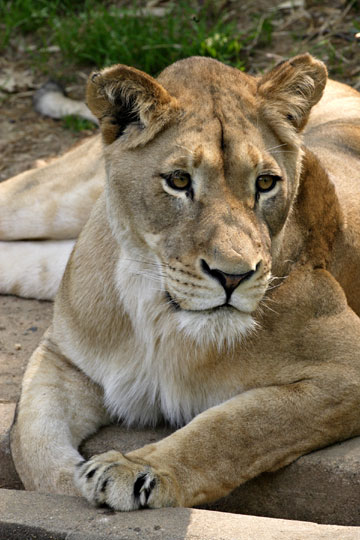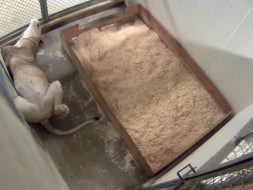The pitter-patter of tiny paws at the Zoo
For the first time in more than 20 years, tiny lion paws are making a mark at the Smithsonian’s National Zoo. Early this morning 6-year-old lion Nababiep gave birth to one cub, adding another member to the lion pride the Zoo has carefully worked to build over the past year.
“This is a historic moment for the National Zoo and positions us to contribute even more significantly to the conservation of African lions and to become leaders in the captive management of a pride,” said Dennis Kelly, director of the National Zoo. “We hope everyone shares our excitement and will help us welcome the cub enthusiastically.”
The cub was born around 4 a.m. May 18 and since then has been mobile and appears to have nursed. Because it is not uncommon for intervals between births to be several hours long, keepers will continue to monitor Nababiep for additional cubs. Visitors to the Zoo’s website can view the cub online during the coming weeks on the new lion cub cam. The cub will not be out in the yard, however, until later this summer, which will give the Zoo’s animal keepers and veterinary team time to examine it and monitor Nababiep as she adjusts to being a first-time mother. In the wild, lions may wait up to six weeks before introducing their cubs to the rest of the pride.
Although the Zoo has managed lions in the past, it has been many years since it had the right combination of animals by age and gender to develop a pride. Doing so successfully has required extensive planning, knowledge of the species’ natural history and an understanding of the individual animals involved.
The Zoo has slowly introduced its two female African lions (Panthera leo), Nababiep and her sister Shera, to male lion, Luke, in its effort to build a pride. Over the past few weeks, keepers have gradually separated the three again to give Nababiep privacy and emulate the natural process. The birth of the lion cub marks the next step in building a pride, and keepers will slowly introduce the cub to its aunt, 5-year-old Shera, and father, 4-year-old Luke, with the aim of eventually bringing all four lions together.

The National Zoo’s 6-year-old lion, Nababiep, gave birth to one cub early this morning. Because it is not uncommon for intervals between births to be several hours long,
“The birth of Naba’s cub represents our team’s hard work to successfully introduce our lions, but we still have many exciting and challenging goals ahead,” said Rebecca Stites, a lion and tiger keeper at the Zoo. “I’m really looking forward to watching the cub experience everything for the first time—the first time it goes outside, plays with its first toys and meets the other adults in its pride.”
In the wild, a typical male lion becomes the resident male in a pride, which consists of related females and offspring, at the age of 4. Although females in a pride do more than 80 percent of the hunting, the social structure of a pride is more complex than researchers once thought. For example, in smaller prides, males may be more active in hunting. The formation of prides makes lions unique among the great cats, many of which are solitary animals. Hunting, disease and habitat loss have contributed to a decline in the population of African lions, which are considered a vulnerable species by the International Union for Conservation of Nature.
“Cubs are a huge draw for the public and are natural ambassadors for their species,” said Kristen Clark, a lion and tiger keeper. “Visitors will be able to watch the cub grow up with its mother, aunt and father—the way it would in a defined social pride in the wild.”
Ford video and photos of the lion introductions, visit the National Zoo’s website. To follow the Zoo’s progress in building a lion pride, read the updates from the Zoo’s lion keepers and check for updates on the Zoo’s Twitter feed and Facebook page.
UPDATED May 21, 2010
National Zoo Mourns Loss of Newborn Lion
Last evening the National Zoo’s lion cub died. Lion keepers had been closely observing the cub, a male, via camera since his birth Tuesday morning. When keepers noticed the cub was not responding to its mother, they shifted the mother outdoors in order to examine the cub. A veterinary team confirmed his death.
Pathologists performed the necropsy and found a straw awn (the pointed tip on a blade of straw) in the cub’s lungs, which led to pneumonia and was determined to be the cause of death. The use of straw bedding for animals, including great cats, is common throughout zoos. There was only organic material in the lions’ den.
“Losing this lion cub is devastating for all of us at the National Zoo,” said Dennis Kelly, director of the National Zoo. “I believe this was a one-in-a-million fluke. Unfortunately, this is the downside to the ‘cycle of life.’ But, the animal care team and Zoo staff are consummate professionals, and I know they’ve learned a tremendous amount from creating the pride, breeding the lions and getting Nababiep through her first birth. We mourn this loss yet keep our focus on the best care for the lion pride.”
Nababiep, the mother, has rejoined her sister Shera, and keepers plan to reunite the females with Luke, the male, very soon. Keepers will continue to watch the pride closely as this was the first cub for Nababiep.
Posted: 18 May 2010
-
Categories:
Feature Stories , Science and Nature , Zoo & Conservation Biology Institute




